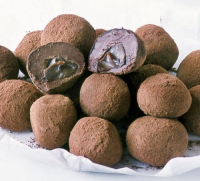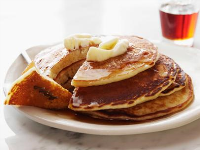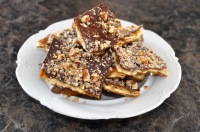CROISSANTS RECIPE | MARTHA STEWART

Follow our step-by-step croissant recipe to make a classic baked good worthy of a French pastry shop.
Provided by Martha Stewart
Categories Breakfast & Brunch Recipes
Yield Makes about 20 croissants
Number Of Ingredients 11
Steps:
- Make the dough: Stir yeast, water, and 1 teaspoon sugar in a bowl. Let stand until foamy, about 5 minutes. Butter a large bowl; set aside. Put bread flour, all-purpose flour, remaining 3 tablespoons plus 2 teaspoons sugar, and the salt into the bowl of an electric mixer fitted with the dough hook; mix on low speed until combined. Add yeast mixture, milk, and butter; mix until dough just comes together.
- Knead dough: Scrape dough out onto a lightly floured work surface. Using lightly floured hands, knead until smooth, about 3 minutes. Transfer to buttered bowl, turning to coat.
- Let dough rise: Cover dough with plastic wrap; transfer to the refrigerator. Let rise until doubled in bulk, about 2 hours (dough should not spring back when you press it with your finger).
- Make the butter package: About 45 minutes after the dough begins rising, put flour and butter into the clean bowl of an electric mixer fitted with the paddle attachment. Mix on medium speed until well combined, 3 to 4 minutes. Scrape butter mixture out onto a piece of parchment paper; shape into a rectangle. Top with parchment, and roll out to an 8-by-10-inch rectangle. Transfer to a baking sheet, and refrigerate 30 minutes.
- Roll out dough: Turn out dough onto a lightly floured work surface; shape into a rectangle. Roll out to a 10 1/2-by-16-inch rectangle, about 1/2 inch thick, with short side facing you.
- Place butter package on dough: The butter package should be cool but pliable; your finger should leave an indentation but the butter should still hold its shape. If too soft, continue to refrigerate; if too firm, let stand at room temperature briefly. Place horizontally on bottom half of dough; remove parchment. Fold top half of dough over butter package, and pinch edges of dough to seal.
- Roll in butter: Turn dough so that a short side is facing you and the seam is on the right. Roll out to a 10-by-20-inch rectangle, about 1/2 inch thick (keep the corners as square as possible).
- Fold dough into thirds: Remove any excess flour with a pastry brush. Starting at the far end, fold rectangle in thirds as you would a business letter (this completes the first of 3 "turns").
- Mark dough: Mark the dough with your knuckle (later, this will help you remember how many turns have been completed). Wrap dough in plastic, and refrigerate 1 hour.
- Repeat process: Remove from refrigerator, and press the dough; it should be pliable but have some resistance. If too soft, return to refrigerator; if too firm, let stand at room temperature, 5 minutes. Repeat the preceding three steps to complete two more turns (make 2 marks for the second turn and 3 marks for the third turn); always start with a short side facing you and the seam on the right, rolling lengthwise before crosswise. After the second turn, wrap dough in plastic, and refrigerate 1 hour. After the third and final turn, wrap dough in plastic, and refrigerate 8 hours (or overnight).
- Roll out and chill dough: Turn out dough onto a lightly floured work surface, and roll out to a 30-by-16-inch rectangle. If dough becomes unmanageable, cut in half crosswise, and roll out two 15-by-16-inch rectangles (refrigerate 1 piece as you work with the other). Chill in freezer 15 minutes. Remove dough, and remeasure: It should match original dimensions; if not, roll out again. If dough becomes too warm or elastic, chill in freezer, 15 minutes.
- Cut dough: Cut dough into two 30-by-8-inch rectangles (or four 15-by-8-inch rectangles). Stack rectangles, lining up edges (if you have four smaller rectangles, make two stacks).
- Trim dough and cut into triangles: Using a pastry or pizza wheel and cutting at a 20-degree angle, trim a small wedge from one short side to create an angled side. Cut dough into triangles, each with a 4 1/2-inch base. You should have about 20 total.
- Cut slits: Cut a 1-inch slit in the middle of the base of each triangle. Separate the stacks, transferring half the triangles to a parchment-lined baking sheet; cover, and refrigerate.
- Begin shaping croissants: Working with one triangle at a time and keeping remaining triangles covered with a clean kitchen towel, hold the two corners of the base, and stretch to lengthen it slightly. Grasp inner corners formed by the slit in the base, and lift and stretch them toward the outer sides of the triangle; press to seal.
- Roll croissants: Using your fingertips, roll the base of the triangle up and away from you, stretching the dough slightly outward as you roll to elongate the point (when finished, the point should be tucked under the croissant).
- Finish shaping croissants: Bend the two ends toward you to form a crescent shape (the ends should almost touch). Transfer to parchment-lined baking sheets, spacing croissants 2 inches apart. Repeat with remaining triangles. Cover loosely with plastic wrap, and let stand in a warm place until croissants have doubled in bulk and are very soft, 1 1/2 hours to 2 1/4 hours, depending on the temperature of room.
- Brush with egg: Preheat oven to 400 degrees, with racks in upper and lower thirds. Brush tops of croissants with egg. Bake, rotating sheets halfway through, until croissants are puffed and golden brown, 20 to 25 minutes. Let cool slightly on sheets on wire racks. Serve warm or at room temperature.
CROISSANTS RECIPE - NYT COOKING

This recipe is a detailed roadmap to making bakery-quality light, flaky croissants in your own kitchen. With a pastry as technical as croissants, some aspects of the process — gauging the butter temperature, learning how much pressure to apply to the dough while rolling — become easier with experience. If you stick to this script, buttery homemade croissants are squarely within your reach. (Make sure your first attempt at croissants is a successful one, with these tips, and Claire Saffitz’s step-by-step video on YouTube.)
Provided by Claire Saffitz
Total Time P1D
Yield 8 croissants
Number Of Ingredients 11
Steps:
- Twenty-four hours before serving, start the détrempe: In the bowl of a stand mixer fitted with the dough hook, combine the flour, sugar, salt and yeast, and stir to combine. Create a well in the center, and pour in the water and milk. Mix on low speed until a tight, smooth dough comes together around the hook, about 5 minutes. Remove the hook and cover the bowl with a damp towel. Set aside for 10 minutes.
- Reattach the dough hook and turn the mixer on medium-low speed. Add the butter pieces all at once and continue to mix, scraping down the bowl and hook once or twice, until the dough has formed a very smooth, stretchy ball that is not the least bit sticky, 8 to 10 minutes.
- Form the dough into a ball and place seam-side down on a lightly floured work surface. Using a sharp knife, cut two deep perpendicular slashes in the dough, forming a “+.” (This will help the dough expand into a square shape as it rises, making it easier to roll out later.) Place the dough slashed-side up inside the same mixing bowl, cover with plastic wrap and let rise at room temperature until about 1 1/2 times its original size, 45 minutes to 1 hour. Transfer the bowl to the refrigerator and chill for at least 4 hours and up to 12.
- As the dough chills, make the butter block: Place the sticks of butter side-by-side in the center of a large sheet of parchment paper, then loosely fold all four sides of the parchment over the butter to form a packet. Turn the packet over and use a rolling pin to lightly beat the cold butter into a flat scant 1/2-inch-thick layer, fusing the sticks and making it pliable. (Don’t worry about the shape at this point.) The parchment may tear. Turn over the packet and unwrap, replacing the parchment with a new sheet if needed. Fold the parchment paper over the butter again, this time making neat, clean folds at right angles (like you’re wrapping a present), forming an 8-inch square. Turn the packet over again and roll the pin across the packet, further flattening the butter into a thin layer that fills the entire packet while forcing out any air pockets. The goal is a level and straight-edged square of butter. Transfer the butter block to the refrigerator.
- Eighteen hours before serving, remove the dough from the refrigerator, uncover and transfer to a clean work surface. (It will have doubled in size.) Deflate the dough with the heel of your hand. Using the four points that formed where you slashed the dough, stretch the dough outward and flatten into a rough square measuring no more than 8 inches on one side.
- Place 2 pieces of plastic wrap on the work surface perpendicular to each other, and place the dough on top. Wrap the dough rectangle, maintaining the squared-off edges, then roll your pin over top as you did for the butter, forcing the dough to fill in the plastic and form an 8-inch square with straight sides and right angles. Freeze for 20 minutes.
- Remove the butter from the refrigerator and the dough from the freezer. Set aside the butter. Unwrap the dough (save the plastic, as you’ll use it again) and place on a lightly floured surface. Roll the dough, dusting with flour if necessary, until 16 inches long, maintaining a width of 8 inches (barely wider than the butter block). With a pastry brush, brush off any flour from the surface of the dough and make sure none sticks to the surface.
- You’re going to enclose the butter block in the dough and roll them out together. To ensure they do so evenly, they should have the same firmness, with the dough being slightly colder than the butter. The butter should be chilled but able to bend without breaking. If it feels stiff or brittle, let sit at room temperature for a few minutes. Unwrap the butter just so the top is exposed, then use the parchment paper to carefully invert the block in the center of the dough rectangle, ensuring all sides are parallel. Press the butter gently into the dough and peel off the parchment paper. You should have a block of butter with overhanging dough on two opposite sides and a thin border of dough along the other two.
- Grasp the overhanging dough on one side and bring it over the butter toward the center, then repeat with the other side of the dough, enclosing the butter. You don’t need the dough to overlap, but you want the two sides to meet, so stretch it if necessary, and pinch the dough together along all seams so no butter peeks out anywhere. Lift the whole block and dust a bit of flour underneath, then rotate the dough 90 degrees, so the center seam is oriented vertically.
- Orient the rolling pin perpendicular to the seam and lightly beat the dough all along the surface to lengthen and flatten. Roll out the dough lengthwise along the seam into a 24-inch-long, 1/4-inch-thick narrow slab, lightly dusting underneath and over top with more flour as needed to prevent sticking. Rather than applying pressure downward, try to push the dough toward and away from you with the pin, which will help maintain even layers of dough and butter. Remember to periodically lift the dough and make sure it’s not sticking to the surface, and try your best to maintain straight, parallel sides. (It’s OK if the shorter sides round a bit — you’re going to trim them.)
- Use a wheel cutter or long, sharp knife to trim the shorter ends, removing excess dough where the butter doesn’t fully extend and squaring off the corners for a very straight-edged, even rectangle of dough. Maintaining the rectangular shape, especially at this stage, will lead to the most consistent and even lamination. If at any point in the process you see air bubbles in the dough while rolling, pierce them with a cake tester or the tip of a paring knife to deflate and proceed.
- Dust any flour off the dough’s surface. Grasp the short side of the rectangle farther from you and fold it toward the midline of the dough slab, aligning the sides. Press gently so the dough adheres to itself. Repeat with the other side of the dough, leaving an 1/8-inch gap where the ends meet in the middle. Now, fold the entire slab in half crosswise along the gap in the center. You should now have a rectangular packet of dough, called a “book,” that’s four layers thick. This is a “double turn,” and it has now quadrupled the number of layers of butter inside the dough.
- Wrap the book tightly in the reserved plastic. If it is thicker than about 1 1/2 inches, or if it’s lost some of its rectangularity, roll over the plastic-wrapped dough to flatten it and reshape it. Freeze the book for 15 minutes, then refrigerate for 1 hour.
- Let the dough sit at room temperature for about 5 minutes. Unwrap and place on a lightly floured surface. Beat the dough and roll out as before (Step 10) into another long, narrow 3/8-inch-thick slab. It should be nice and relaxed, and extend easily. Dust off any excess flour.
- Fold the dough in thirds like a letter, bringing the top third of the slab down and over the center third, then the bottom third up and over. This is a “simple turn,” tripling the layers. Press gently so the layers adhere. Wrap tightly in plastic again and freeze for 15 minutes, then refrigerate for 1 hour.
- Let the dough sit at room temperature for about 5 minutes, then unwrap and place on a lightly floured surface. Beat the dough and roll out as before, but into a 14-by-17-inch slab (15-by-16-inch for pain au chocolat or ham and cheese croissants). The dough will start to spring back, but try to get it as close to those dimensions as possible. Brush off any excess flour, wrap tightly in plastic, and slide onto a baking sheet or cutting board. Freeze for 20 minutes, then chill overnight (8 to 12 hours). If making pain au chocolat or ham and cheese croissants, see recipes.
- Four and a half hours before serving, arrange racks in the upper and lower thirds of the oven. Bring a skillet of water to a simmer over medium-high heat. Transfer the skillet to the floor of the oven and close the door. (The steam released inside the oven will create an ideal proofing environment.)
- As the steam releases in the oven, line two rimmed baking sheets with parchment paper and set aside. Let the dough sit at room temperature for about 5 minutes. Unwrap (save the plastic for proofing), place on a very lightly floured surface, and, if necessary, roll out to 17-by-14 inches. Very thoroughly dust off any excess flour with a pastry brush. Use a wheel cutter or long knife and ruler to cut the shorter sides, trimming any irregular edges where not all the layers of dough fully extend and creating a rectangle that’s exactly 16 inches long, then cut into four 4-by-14-inch rectangles.
- Separate the rectangles, then use the ruler and wheel cutter to slice a straight line from opposite corners of one rectangle to form two long, equal triangles. Repeat with the remaining rectangles to make 8 triangles. Trim the short side of each triangle at a slight angle, making them into triangles with longer sides of equal length.
- Working one triangle at a time, grasp the two corners of the shorter end, the base of the crescent, and tug gently outward to extend the points and widen the base to about 3 inches. Then, gently tug outward from about halfway down the triangle all the way to the point, to both lengthen the triangle and thin the dough as it narrows. Starting at the base (the short end), snugly roll up the dough, keeping the point centered and applying light pressure. Try not to roll tightly or stretch the dough around itself. Place the crescent on one of the parchment-lined baking sheets, resting it on the point of the triangle. If the dough gets too soft while you’re working, cover the triangles and freeze for a few minutes before resuming rolling. Space them evenly on the baking sheets, four per sheet. Very loosely cover the baking sheets with plastic wrap, so the croissants have some room to expand.
- Three and a half hours before serving, open the oven and stick your hand inside: It should be humid but not hot, as the water in the skillet will have cooled. You want the croissants to proof at 70 to 75 degrees. (Any hotter and the butter will start to melt, leading to a denser croissant.) Place the baking sheets inside the oven and let the croissants proof until they’re about doubled in size, extremely puffy, and jiggle delicately when the baking sheet is gently shaken, 2 to 2 1/2 hours. Resist the urge to touch or poke the croissants as they proof: They’re very delicate. Try not to rush this process, either, as an underproofed croissant will not be as light and ethereal.
- Remove the baking sheets from the oven and carefully uncover them, then transfer to the refrigerator and chill for 20 minutes while you heat the oven. Remove the skillet from the oven and heat to 375 degrees.
- In a small bowl, stir the yolk and heavy cream until streak-free. Using a pastry brush, gently brush the smooth surfaces of each crescent with the yolk and cream mixture, doing your best to avoid the cut sides with exposed layers of dough.
- Transfer the sheets to the oven and bake for 20 minutes. Rotate the baking sheets and switch racks, and continue to bake until the croissants are deeply browned, another 10 to 15 minutes. Remove from the oven and let cool completely on the baking sheets.
More about "homemade croissant recipes"
HOMEMADE CHOCOLATE CROISSANTS (PAIN AU CHOCOLATE) RECIPE ...
Here's what you need: flour, water, milk, sugar, salt, instant dry yeast, unsalted butter, cold unsalted butter, egg, sweetened chocolate bar
From tasty.co
Reviews 93
Cuisine French
Calories 687 calories per serving
From tasty.co
Reviews 93
Cuisine French
Calories 687 calories per serving
- Enjoy!
See details
CROISSANT DOUGH RECIPE | EPICURIOUS
It's important not to try to halve this recipe. When you need only a half recipe of dough, as for the pains au chocolat, use the rest of the dough for a batch of Parma braids or a princess ring. Or make a double recipe of those irresistible chocolate croissants and share them with friends.
From epicurious.com
Reviews 3.7
Total Time 14 hr
From epicurious.com
Reviews 3.7
Total Time 14 hr
- Make 3 more folds in same manner, chilling dough 1 hour after each fold, for a total of 4 folds. (If any butter oozes out while rolling, sprinkle with flour to prevent sticking.) Wrap dough tightly in plastic wrap and chill at least 8 hours but no more than 18 (after 18 hours, dough may not rise sufficiently when baked).
See details
BUTTERY CRESCENT ROLLS RECIPE: HOW TO MAKE IT
I always have to double this buttery, homemade crescent roll recipe because they never last long. You can shape them any way you'd like, but to me, a crescent shape is so pretty. —Kelly Kirby, Westville, Nova Scotia
From tasteofhome.com
Reviews 4.7
Total Time 45 minutes
Calories 128 calories per serving
From tasteofhome.com
Reviews 4.7
Total Time 45 minutes
Calories 128 calories per serving
- In a large bowl, dissolve yeast and 1 teaspoon sugar in warm water. Add butter, milk, egg, salt, remaining sugar and 2 cups flour. Beat until smooth. Stir in enough remaining flour to form a soft dough., Turn onto a floured surface; knead until smooth and elastic, 6-8 minutes. Place in a greased bowl, turning once to grease the top. Cover and let rise in a warm place until doubled, about 1 hour., Punch dough down. Turn onto a lightly floured surface; divide in half. Roll each portion into a 12-in. circle; cut each circle into 12 wedges. Roll up wedges from the wide end and place point side down 2 in. apart on greased baking sheets. Curve ends to form crescents. Cover and let rise in a warm place until doubled, about 30 minutes. , Preheat oven to 350°. Bake until golden brown, 10-12 minutes. Remove from pans to wire racks.
See details
HOMEMADE CROISSANTS - JO COOKS
Apr 01, 2019 · How to Make Croissants Bloom the yeast: In the bowl of your mixer, add the warm milk, brown sugar, and yeast. Give it a quick stir with a fork... Make the dough: To your bloomed yeast, add the flour and salt. Use the dough hook on your mixer and let the dough knead... Prepare the butter: Arrange the ...
From jocooks.com
From jocooks.com
See details
BAKER'S CROISSANTS | KING ARTHUR BAKING
Brush each croissant with an egg beaten with 1 tablespoon water. Bake for 15 minutes, then reduce the oven’s temperature to 350°F and bake for 10 to 15 minutes more, until deep golden brown and no raw dough is visible where the layers overlap.
From kingarthurbaking.com
From kingarthurbaking.com
See details
EASY CROISSANT RECIPE: THIS WAY IS SO MUCH EASIER! -BAKING ...
Feb 06, 2019 · Notch the wide end of each triangle with about a 1/2-inch cut, then roll from the wide end to the pointed end, tucking the point under the croissant. Place on a parchment-lined baking sheet, cover loosely with plastic wrap, and allow to proof until doubled in size (1 to 2 hours).
From bakingamoment.com
From bakingamoment.com
JULIA CHILD'S CROISSANT RECIPE - ORG
Nov 10, 2020 · Let croissants rise for an hour or more at room temperature, until almost doubled, and light in texture. (Risen croissants may be frozen, then baked while still frozen.) Glazing and Baking. Ingredients: 1 egg beaten with ½ tsp water (Preheat oven to 475 degrees.) Set rack in middle level. Paint croissants with the egg to glaze them. Bake for 10 to 12 minutes, until nicely browned.
From wgbh.org
From wgbh.org
See details
CROISSANTS RECIPE | MARTHA STEWART
Make the dough: Stir yeast, water, and 1 teaspoon sugar in a bowl. Let stand until foamy, about 5 minutes. Butter a large bowl; set aside. Put bread flour, all-purpose flour, remaining 3 tablespoons plus 2 teaspoons sugar, and the salt into the bowl of an electric mixer fitted with the dough hook; mix on low speed until combined.
From marthastewart.com
From marthastewart.com
See details
BAKER'S CROISSANTS | KING ARTHUR BAKING
Instructions. For the dough: Put the eggs and water in a large mixing bowl. Add 1 tablespoon of the sugar, 3 cups (362g) of the flour, and the yeast. Mix until well blended; set aside to let the sponge work. For the butter: Cut the butter into 1? chunks and combine with the salt and flour at low speed in a stand mixer fitted with the paddle ...
From kingarthurbaking.com
From kingarthurbaking.com
See details
QUICK BUTTER CROISSANTS RECIPE | ALLRECIPES
Let stand until creamy, about 10 minutes. Stir in milk, salt, sugar, 1 egg, 1 cup flour and melted butter. Beat to make a smooth batter; set aside. Advertisement. Step 2. In a large bowl, cut the one cup firm butter into remaining four cups flour until butter particles are the size of dried kidney beans.
From allrecipes.com
From allrecipes.com
See details
HOW TO MAKE HOMEMADE CROISSANTS : 16 STEPS (WITH PICTURES ...
Use a rolling pin, pound the butter into an 8-inch square (the measurements will be important). Take the dough out from the refrigerator and on a lightly floured surface, roll the dough into a 9 x 17-inch rectangle. Take the square of butter and place it gently on the bottom half of the rectangle.
From instructables.com
From instructables.com
See details
HOMEMADE CLASSIC CROISSANT RECIPE - ALL THINGS BREAD
Aug 25, 2021 · Cover the bowl with a clean towel and let sit at room temperature for approximately 40-60 minutes. On a lightly floured flat surface punch the dough down and form in to a ball, place in a clean bowl, cover and refrigerate for one hour. Remove the dough from the fridge and roll into a 9x15 inches (23x40cm) rectangle.
From allthingsbread.com
From allthingsbread.com
See details
HOMEMADE CROISSANTS (WITH STEP-BY-STEP PHOTOS) - HALF ...
Sep 15, 2013 · After one hour position a rack in the middle of the oven and preheat to 425 degrees. Lightly brush the tops of the pastries with the egg mixture. Bake the pastries, 1 sheet at a time, until golden brown, 15-18 minutes. Transfer to a wire rack and let cool on the pan. DEVOUR.
From halfbakedharvest.com
From halfbakedharvest.com
See details
28 BEST CRESCENT ROLL RECIPE IDEAS | WHAT TO MAKE WITH ...
Dec 01, 2021 · These recipes will inspire you to keep crescent roll dough on hand year-round, so you’re ready anytime a craving for something golden-brown and delicious strikes. December 01, 2021 Save Collection
From foodnetwork.com
From foodnetwork.com
See details
EASY HOMEMADE CROISSANT RECIPE – MY ROI LIST
Oct 09, 2021 · This simplified croissant recipe will have you baking croissants like a pro. Flaky, buttery, and deliciously authentic, yet so easy to make! Today I am sharing a recipe that has been on my bucket list for years: homemade croissants! I’ve wanted to try making them forever, and there are TONS of croissant recipes out there to choose from.
From myroilist.com
From myroilist.com
See details
CROISSANT RECIPE | PUFF PASTRY RECIPE | EASY CROISSANT ...
Croissant recipe | Puff pastry recipe | Easy Croissant | Homemade Croissant | Quick Croissant
From m.youtube.com
From m.youtube.com
See details
EASY HOMEMADE CROISSANT RECIPE - YOUTUBE
This simplified croissant recipe will have you baking croissants like a pro. Flaky, buttery, and deliciously authentic, yet so easy to make!SUBSCRIBE to this...
From m.youtube.com
From m.youtube.com
See details
CROISSANTS RECIPE | BBC GOOD FOOD
Cinnamon & raisin: Mix together 100g muscovado sugar and 1 tbsp ground cinnamon, then sprinkle over the unrolled croissant dough. Scatter over raisins, then shape and bake. Cheese & ham: Lay a slice of ham and a slice of cheese on top of each triangle of dough and shape as in the recipe.
From bbcgoodfood.com
From bbcgoodfood.com
See details





























